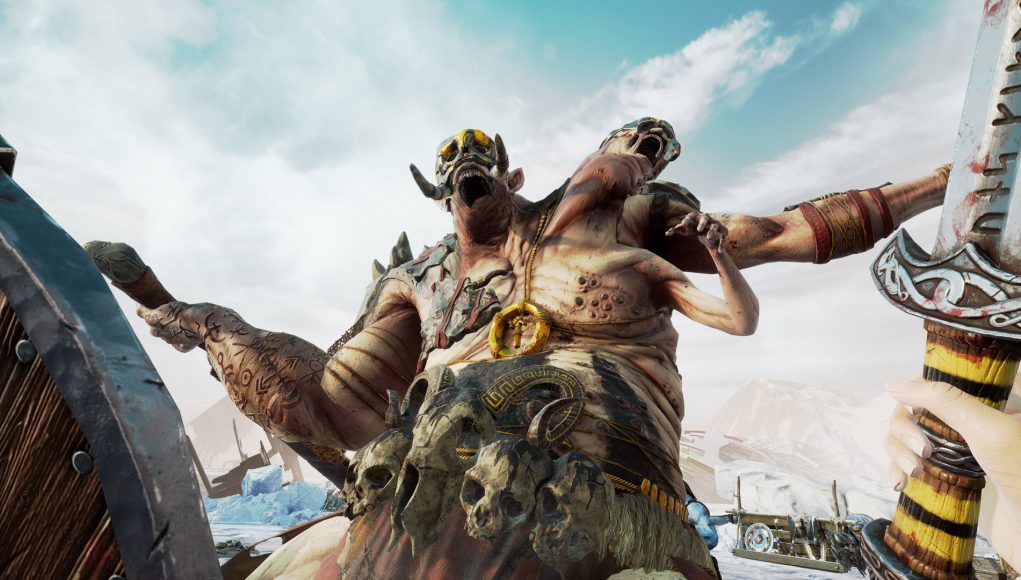Sanzaru Games made some pretty big claims about Asgard’s Wrath when it was first revealed earlier this year, calling it their “deepest title yet” and promising 30+ hours of first-person combat, dungeoning, and all of the RPG goodness you could hope for. And although the term ‘AAA’ has been bandied about, it seems the hype is mostly well-founded here: besides some fairly minor gripes, Asgard’s Wrath sets a new bar for VR-native RPGs.
Asgard’s Wrath Details:
Developer: Sanzaru Games
Publisher: Oculus
Available On: Oculus Store (Rift)
Reviewed On: Rift CV1
Release Date: October 10th, 2019
Price: $40
Gameplay
Here’s the setup: you’re the new fledgling demigod in town, and the Norse trickster god Loki has taken a shine to you after you successfully saved him in an epic battle with a Kraken. Sharing a flagon of ale back in Aegir’s Hall, the Asgardian version of Applebee’s, Loki implores you to embark on a grand journey to possess a number of mortal heroes and guide them along their individual quests—all the while collecting a unique gemstone extracted from each hero, which you ultimately fork over to Loki.
If you’ve ever seen any of the more recent Marvel movies or thumbed through the real page-turner that is the Poetic Edda, then you’re probably pretty familiar with the basics of Norse mythology, and you’ll likely know what’s going on well before it’s spelled out for you by Loki, Thor, Freya, Odin and the gang. The whole setup is admittedly well-trodden territory story-wise, and although Asgard’s Wrath lacks what you might call a fresh narrative, it more than makes up for this with visual finesse, a consistent combat system, a massive number of quests & side quests, and more loot than you can shake a sword at.
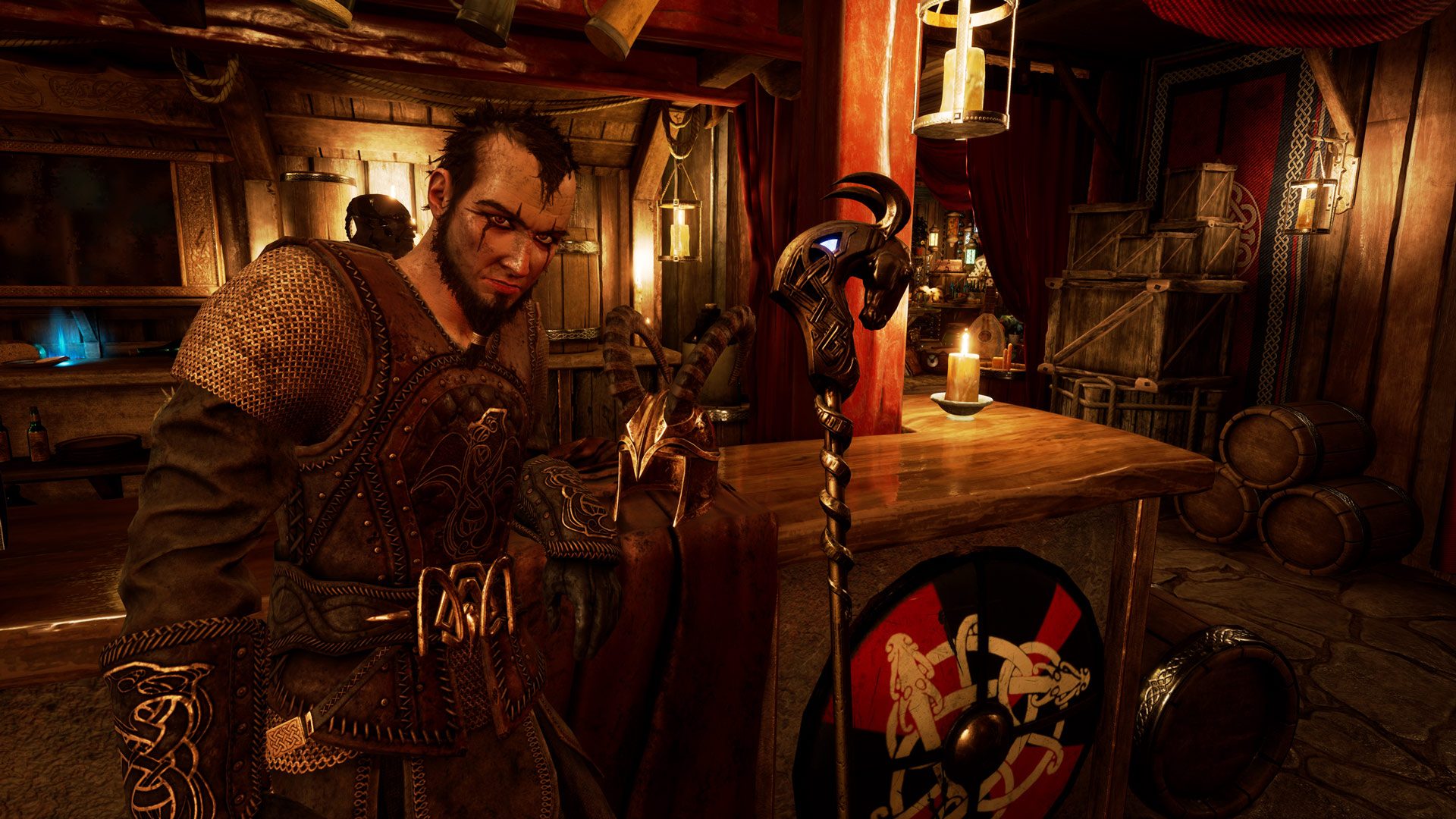
It essentially includes many of the components that you may have dreamt of the first time you imagined what Skyrim might be like if it was made from the ground up for VR, though it doesn’t offer a truly open world.
Asgard’s Wrath is very much a structured world with one-way trips through its discrete levels which are splayed across the source material’s various realms, however Sanzaru showcases a more clear understanding of what makes VR great. Hint: it’s not an avalanche of text-based 2D menus like we saw in the actual Skyrim VR port.
Firstly, let’s talk about combat. Asgard’s Wrath takes more of a gestural approach to combat rather than a highly simulated approach, meaning all of your hard-won combat strategies learned in Blade and Sorcery are basically no good here. Because it doesn’t feature a pure physics-based combat system, weapons have a characteristic ‘weightlessness’ that will result in you clipping through an enemy if you don’t swing with enough force. Although this fundamentally negates your first instinct to start slashing and going for the soft squishy bits, you do get used to it over time and it does become reliable and predictable if you play by the rules of combat which the game sets out for you.
That doesn’t mean you can’t get away with wailing on a high level baddie with dumb-baby tactics though, and ignoring all advice about parrying, blocking, and countering by just slashing away and dodging with thumbstick locomotion all the time. You can totally go that route, though it takes a much longer time to take down high-level enemies.
Most mid to high-level baddies are enveloped in a magical shield that can only be broken by effectively anticipating a special attack and parrying it before it lands, or alternatively by throwing tons of attacks to chip away at the magic shield until you can start doing HP damage. Clearly the game wants you to engage in a very specific combat style, which removes some of the fun of creatively dispatching a bad guy, although once you learn how the game wants you to engage in combat, it becomes mostly second nature. You learn what constitutes a ‘good’ swing, and you can at least mix and match ranged and melee combat to your tastes thanks to lootable enemy weapons.
Although it’s a single-player game, at your side is a cast of loyal beast-warriors called ‘Followers’ that you can create and collect along the way. Not only do they provide an extra hand during combat, but each Follower has its own special ability for puzzle solving too. All stages have multiple side quests and special areas that only a specific Follower can help with, which means you’ll have to go back through the completed stages to exhaust every possible secret and collect the most epic hidden loot. Thankfully you can both summon and swap you Follower at any time, so it doesn’t become a painful exercise in escorting a stupid AI to a specific place. You just point and click where you want them, or what to attack, and they mostly get out of the way.
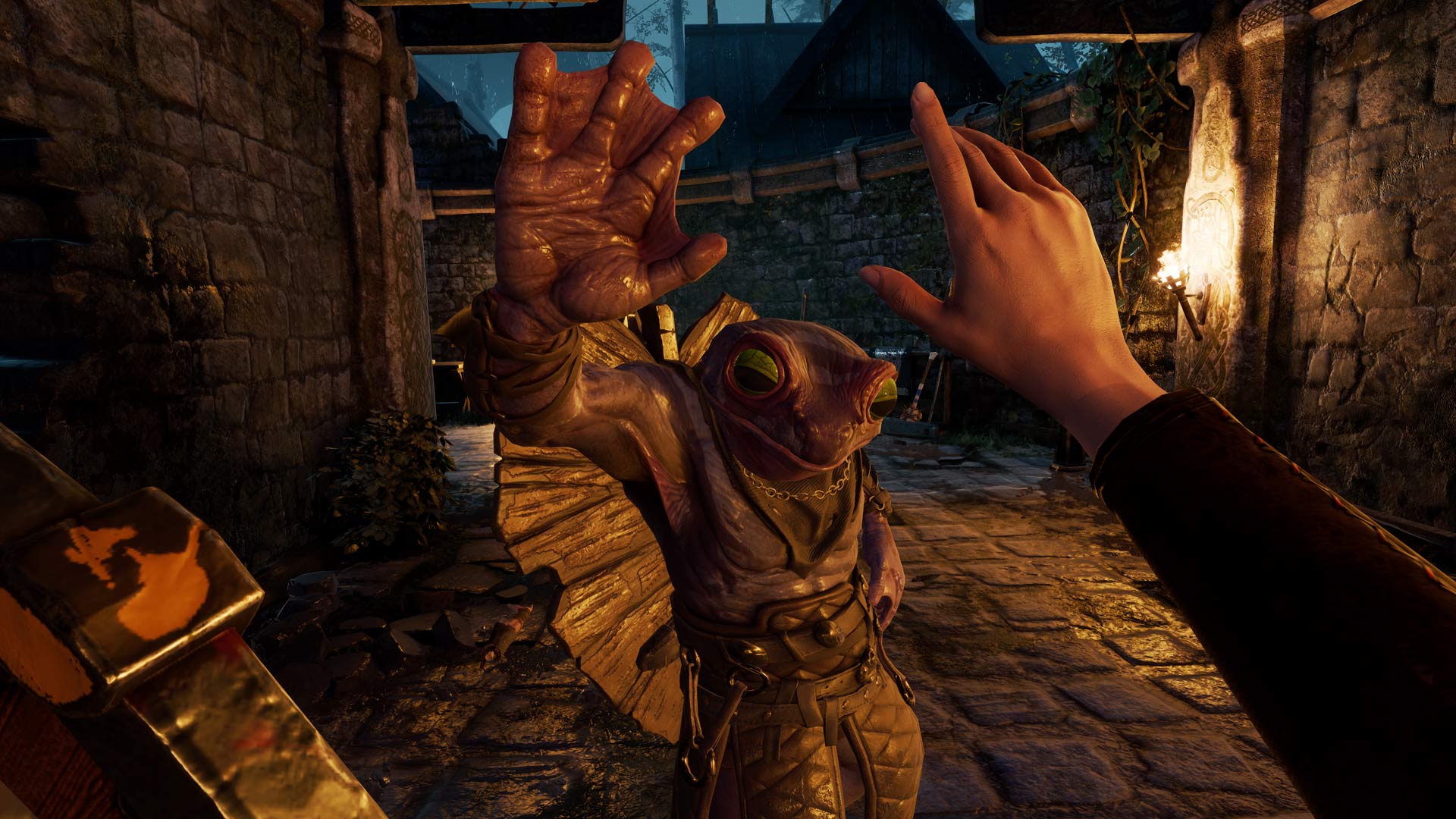
And where are you going to store all of those ill-gotten gains from your many exploits? Well, in your insanely large inventory of course! Ok, let’s face it. Unrealistically large inventories may never truly find a compelling VR-native solution beyond bringing a literal room-sized backpack with you, although Asgard’s Wrath does well enough with its inventory system, which gives you three main ways of storing stuff. It gives you a more traditional 2D menu-based depository, a quick select wheel with a limited number of spots for faster in-world selection, and finally a holster system, which you can configure to hold anything in a limited number of spots. Want to store all your sausages on your right shoulder and a bunch of cabbages on your left leg? Be my guest, you miserable weirdo. You’d probably be better off stocking Full Potions and Revival Mead for your Follower, but I’m not your dad.
If I were your dad though, I would say that you should write Sanzaru a nice letter for making a useful, VR-native inventory system that lets you configure your loadout anyway you see fit. Of course it sucks that you can only store a number of item types before you fill up with garbage and you start refusing to carry actually useful or rare stuff, but you can always jump out to Aegir’s Hall anytime to craft items, and store/sell excess junk and convert it to the game’s only currency, Hacksilver.
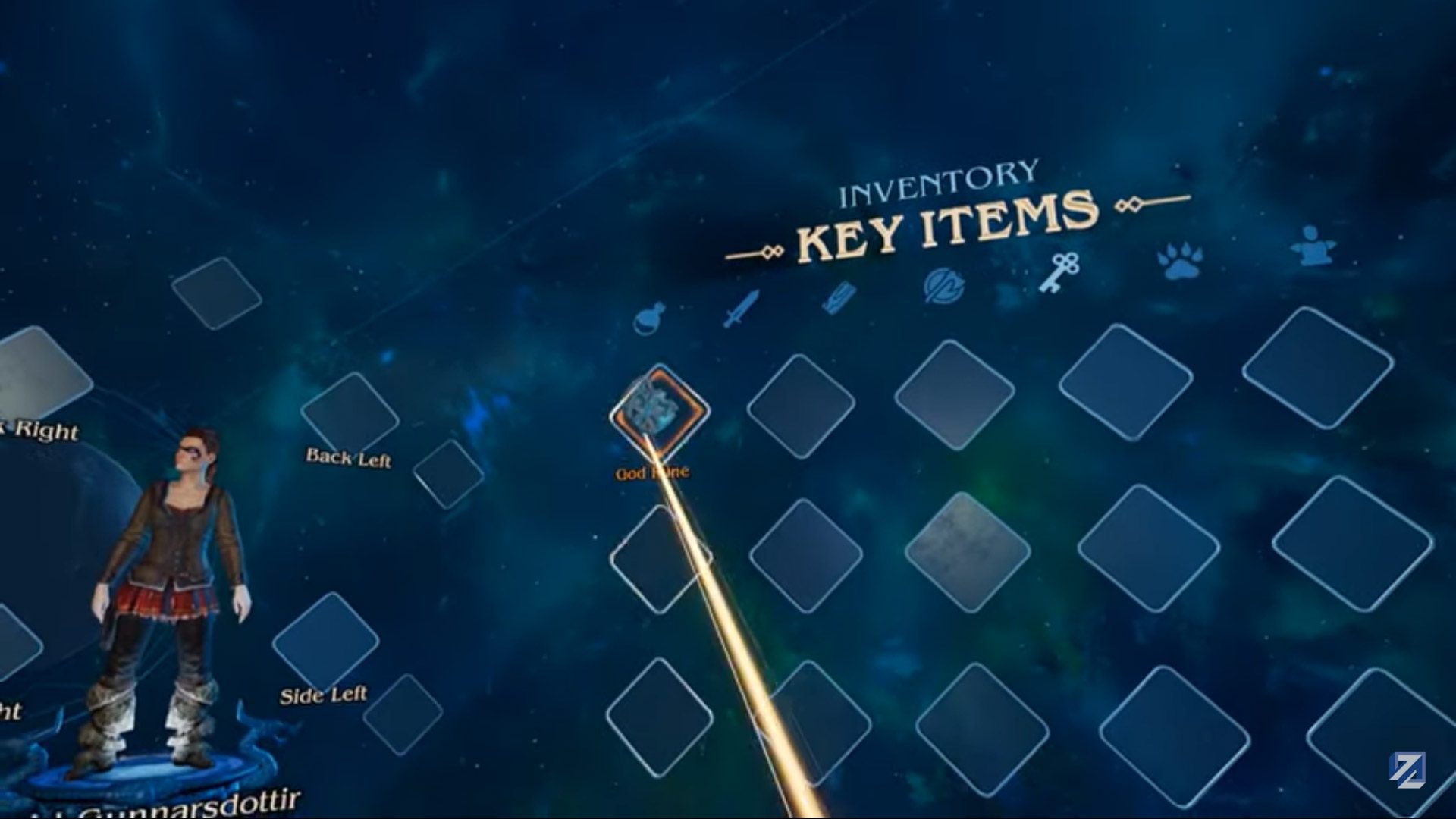
Puzzles, although not the toughest, are varied enough to present an engaging mix of challenges that more often than not require you to pay close attention to your surroundings and act quickly. Things like shooting challenges, symbol-matching, key item collection, and door puzzles are all in rotation here. Although most of this is done while possessing a hero, there are some puzzles that you undertake in god-mode as well.
As a god you are a giant and tower over the landscape, giving you a birds-eye view of some of the game’s environments. This is a great way get the lay of the land and even scout for secrets before jumping back down to human scale by possessing the Hero that you’re aiding. In god mode you can also move the Followers by hand, which is useful for some puzzles.
And there’s the gameplay length, something VR fans have bemoaned since before consumer headsets were even a thing. Going primarily through main quests, and not stopping to dig deeply into crafting, weapon upgrades, excessive inventory management, and the many side quests, my personal play time came to just under 17 hours. That’s a bit short of the advertised 30+, but I would almost consider my personal playthrough a hard bottom for a first run. Had I gone for the highest difficulty level, and really squeezed the loot around me for the best crafting items so I could level my hero’s gear and my various beastly companion’s gear, I could easily see myself doubling that time. Replay value, like I said before, is dependent on your will to replay parts of the game with the full set of followers so you can open corresponding chests and hidden side quests.
Side note: loading screens are frequent and can be an absolute drag if you’re loading from a standard hard disk and not an SSD, so you will definitely want to make room on your fastest drive for the best experience.
Immersion
Asgard’s Wrath is a pretty significant technical achievement in terms of graphical fidelity, at least as far as VR is concerned. Outside of a few moments when some of the supporting cast’s character designs felt a bit rushed, Asgard’s Wrath is overall a really impressive visual experience, and one that feels rock solid beneath your feet most of the time.
Although characters may not always be the most graphically polished, their animations were always on point, and often times take over the heavy lifting in terms of immersion. To that effect, one of the most impressive areas in the game is Aegir’s Hall; seeing all of the life around me—the patrons, vendors, and band—really felt like I was peeking into the future of VR.
Dynamic lighting and water in some stages adds a thick veneer of realism over well-realized dungeons, each of which seems to have a distinct character depending on which of the game’s locales they inhabit.
I spoke a bit about combat above, and although there’s plenty of mechanics that the creators have essentially ported over from non-VR combat games (which sometimes feel out of place in VR), Asgard’s Wrath thankfully includes toggles for just about everything. You can toggle off the player’s HUD, enemy meters, enemy indicators, and even toggle off throwing aim assist for the most 1:1 combat experience the game can offer.
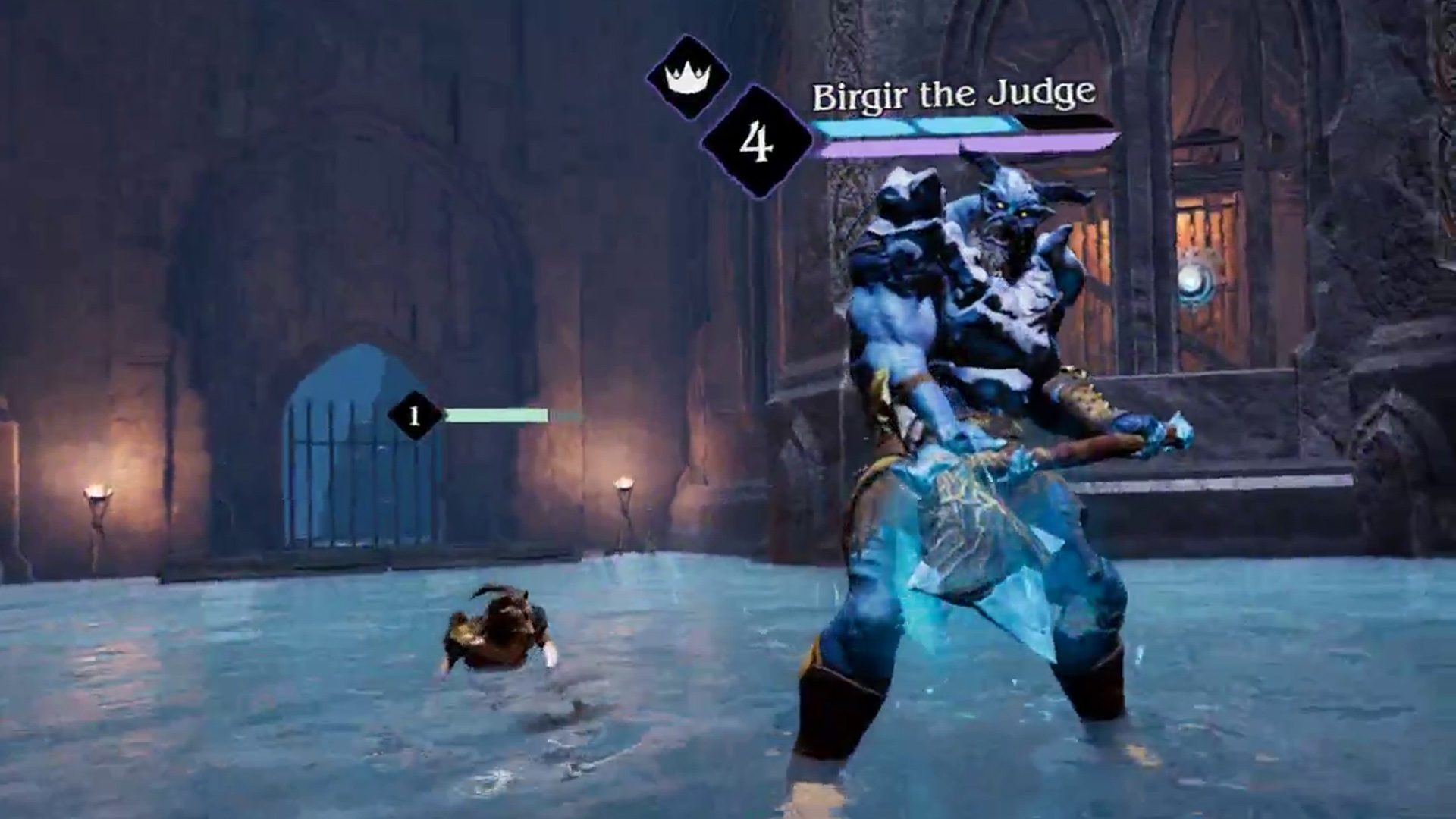
That said, one of the things I’m going to come down on is object interaction. On one hand, the game is absolutely brimming with interactive objects, and stocks the world with very few things that can’t be used, collected, sold, or crafted into something better. On the other hand, every object has a snap-to point where you automatically engage a single holding pose, which can make you feel like you have a wooden grip instead of the sort of flowing and more natural hand poses I wish other developers would borrow from the likes of Lone Echo. Because you’re always picking things up and opening up the game’s many (many) treasure chests, you don’t ever really forget it either.
One such instance of iffy object interaction culminated in a challenge that requires precise and quick manipulation of levers, and I found myself constantly overreaching, or not grabbing the lever at all because I needed to be close enough to the pre-approved attach point for my hand to actually move the lever, even if it was physically in a perfectly reasonable place to ‘grab’.
Comfort
Asgard’s Wrath offers a wide array of comfort options including variable speed/angle snap-turn, a toggle for camera shake, optional blinders, and head or hand-based steering.
Whatever you choose though, this is a stick-based game with smooth forward locomotion and no teleport option. If you’ve sensitive to smooth locomotion Asgard’s Wrath could give you some trouble, though the blinders and movement speed adjustment could make it more tolerable. I found locomotion to be slow enough to not cause any issue, and I remained comfortable after playing multiple hours at a time. A few clever comfort additions, including fast-travel ladders and (optional) fast travel stairs, mean the artificial locomotion is relegated to walking and periodic dashing.
Force grab is also enabled and lets you reach toward and object and pull it into your hand from a distance so you don’t wind up constantly bending down to grab the game’s many items from ground. Force grab isn’t great for immersion per se, but over the course of my multi-hour play sessions it really saved both my neck and my sanity, so I count it as a net positive.
Seated users won’t have a problem playing Asgard’s Wrath. The game automatically detects whether you’re playing seated or standing and adjusts your in-game height accordingly. Like all physical games, you’ll need plenty of room to swing wildly, and a chair without arms is recommended.

